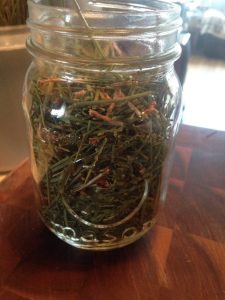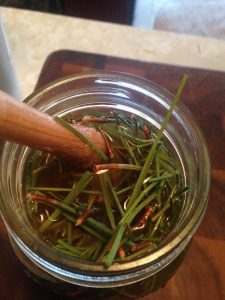Herbal vinegars create a great combination as they combine the healing properties of apple cider vinegar with the nutritional components of plants. Herbal vinegars can be tasty medicine that nourishes and healing our health from the inside out. Vinegar has the amazing ability to draw out the minerals and antioxidants from our health protective medicinal herbs and wild roots. By consuming mineral-rich medicinal herbal vinegars we are making high-quality minerals available to our body. Minerals are very important for the health & proper functioning of our heart & blood vessels, nerves, brain (especially memory), our immune system, our hormonal glands and our bones.
I use organic unpasteurized or pasteurized apple cider vinegar for my herbal vinegars. I avoid white vinegar. Malt vinegar, rice vinegar, and wine vinegar can be used but they are more expensive and may overpower the flavor of the herbs.
Apple cider vinegar has been used as a health-giving agent for centuries. Some of the many benefits of apple cider vinegar include: better digestion, reduction of cholesterol, improvements in blood pressure, prevention/care of osteoporosis, normalization of thyroid/metabolic functioning, possible reduction of cancer risk, and lessening of wrinkles and grey hair.
Pine specifically provides our bodies with vitamin A and C.
You will need the following supplies to make the Pine Needle Herbal Vinegar:
Pine Needles
Knife or Scissors
Mason Jar
Apple Cider Vinegar
Parchment Paper
Label
First things first you must venture out to find some pine needles! Make sure you have properly identified a pine tree and if possible try to collect needles that have already fallen on the ground. This is the pine tree’s gift to you!
Once you have collected the pine needles bring them home and pull them off the branches. You don’t really want to get the woody part in the vinegar.
Now it’s time to chop up the lovely pine needles; you can use a knife or even chop them up with scissors.
The beautiful aroma of pine should be filling the air! The magical smell will be on your hands as well. Take the chopped pine needles and fill your mason jar. Fill it right to the top of the jar.
Grab your apple cider vinegar and pour into the mason jar. Fill it right up to the top so the apple cider vinegar covers all the needles.
I usually take a wooden utensil and push the needles down and add a little more apple cider vinegar if needed.
Once your jar is filled, you can put the lid on! If you have a plastic lid for your mason jar than use that but if you don’t this is where you will use your parchment paper. Cover the top of the jar with a piece of the parchment and then screw on the metal lid. Corrosion will occur is the vinegar touches the metal lid.
And viola! Your pine needle herbal vinegar is ready to sit for six weeks. But before you put it away make a label and put it on the top of the jar. I like to put it on the top to avoid spillage ruining the label. On the label you should put what you have in the jar (latin name of plant is preferred!), date it was created, you could also include when it will be ready or how many weeks until it is ready, and I like to include the location where I collected the plant material.
After six weeks, strain the pine needles from the apple cider vinegar. Now you can enjoy your delicious herbal vinegar in a variety of ways:
* Pour a spoonful or more on beans and grains as a condiment.
* Use them in salad dressings.
* Add them to cooked greens
* Season stir-frys with them.
* Look for soups that are vinegar friendly, like borscht.
* Substitute herbal vinegar for plain vinegar in any recipe.
* Put a big spoonful in a glass of water and drink it. Try it sweetened with blackstrap molasses for a real mineral jolt. Many older women swear this “coffee substitute” prevents and eases their arthritic pains.
* Herbal vinegars in the diet have a reputation for banishing grey hair and wrinkles.
* Anything vinegar can do, including clean the kitchen, herbal vinegars can do better.
Here are some other herbal vinegars to try for a calcium boost:
Amaranth (Amaranthus retroflexus) leaves Cabbage leaves
Chickweed (Stellaria media) whole herb Comfrey (Symphytum officinalis) leaves
Cronewort/Mugwort (Artemisia vulgaris) young leaves Dandelion (Taraxacum off.) leaves and root
Kale leaves Lambsquarter (Chenopodium album) leaves
Nettle (Urtica dioica) leaves Parsley (Petroselinum sativum) leaves
Plantain (Plantago majus) leaves Raspberry (Rubus species) leaves
Red clover (Trifolium pratense) blossoms Violet (Viola odorata) leaves
Yellow dock (Rumex crispus) roots Mallow (Malva neglecta) leaves
Mint leaves of all sorts, especially sage, motherwort, lemon balm, lavender, peppermint
Here are some herbal vinegars that taste so good:
Apple mint (Mentha sp.) leaves, stalks Bee balm (Monarda didyma) flowers, leaves, stalks
Bergamot (Monarda sp.) flowers, leaves, stalks Burdock (Arctium lappa) roots
Catnip (Nepeta cataria) leaves, stalks Chicory (Cichorium intybus) leaves, roots
Chives and especially chive blossoms Dandelion (Taraxacum off.) flower, leaves, roots
Dill (Anethum graveolens) herb, seeds Elder (Sambucus canadensis) berries
Fennel (Foeniculum vulgare) herb, seed Garlic (Allium sativum) bulbs, greens, flowers
Garlic mustard (Alliaria officinalis) leaves and roots Goldenrod (Solidago sp.) flowers
Ginger (Zingiber off.) Lavender (Lavendula sp.) flowers, leaves
Mugwort (Artemisia vulgaris) new growth leaves and roots Peppermint (Mentha piperata and etc.) leaves, stalks
Rosemary (Rosmarinus off.) leaves, stalks Thyme (Thymus sp.) leaves, stalks
Yarrow (Achilllea millifolium) flowers and leaves








 On our magical land, we use permaculture and biodynamic practices to consciously influence the life processes in nature so that harmonious and healing forces will be present in the medicinal herbs we grow and wild-craft.
On our magical land, we use permaculture and biodynamic practices to consciously influence the life processes in nature so that harmonious and healing forces will be present in the medicinal herbs we grow and wild-craft.